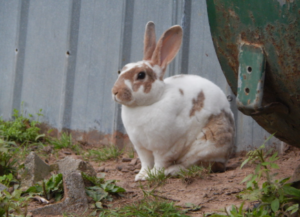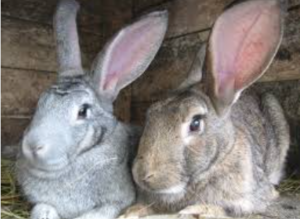Raising rabbits for meat is a rewarding experience, but one of the most critical steps in starting your rabbitry is choosing the right meat rabbit breeds. As a first-time rabbit raiser or even an experienced homesteader, the decision on which breeds to raise can feel overwhelming. There are several factors to consider: growth rates, temperament, size, and even climate adaptability.
In this article, I’ll share my personal journey of selecting meat rabbit breeds, the research I conducted, the breeds I chose, and why they made the cut. Whether you’re new to raising rabbits or looking to expand your rabbitry, this guide will help you make informed decisions.
Why Raising Meat Rabbits Is a Great Idea

Before diving into the breeds, let’s discuss why meat rabbits are an excellent addition to any homestead or farm:
- Efficient Meat Production: Rabbits have a high feed-to-meat conversion ratio, meaning they produce a lot of meat for the amount of feed they consume.
- Sustainable and Low Impact: Rabbits require less space, water, and feed compared to other livestock like cows or pigs.
- Healthy Meat Option: Rabbit meat is lean, high in protein, and low in fat and cholesterol.
- Fast Breeding Cycles: Rabbits reproduce quickly, with a single doe capable of producing up to 6–8 litters per year.
Factors I Considered When Choosing Meat Rabbit Breeds
Choosing the right breed for meat production isn’t just about size. Here are the main factors I evaluated:
- Growth Rate: Faster-growing rabbits mean quicker turnaround times for harvesting.
- Size and Meat Yield: Larger breeds with higher meat-to-bone ratios were a priority.
- Temperament: Calm and easy-to-handle rabbits are easier to manage, especially in breeding programs.
- Adaptability to Climate: I needed breeds that could handle the temperature fluctuations in my region.
- Mothering Ability: I wanted does that were good mothers with high survival rates for their kits.
- Feed Efficiency: Some breeds grow more efficiently on less feed, which is a cost-saving factor.
- Availability: I considered the accessibility of the breeds in my local area.
You may love this post: Can Rabbits Eat Watermelon?
Top Meat Rabbit Breeds I Researched

Here’s a breakdown of the most popular meat rabbit breeds and what I learned about each:
1. New Zealand
- Why It’s Popular: New Zealand rabbits are the gold standard in meat production. They grow fast, reach market weight (5–6 pounds) by 8–10 weeks, and have a high meat-to-bone ratio.
- Temperament: Calm and friendly, making them easy to handle.
- Other Notes: Excellent breeders with large litter sizes.
2. Californian
- Why It’s Popular: Known for their compact size and efficient meat production, Californians are often crossbred with New Zealand rabbits for optimal results.
- Temperament: Generally docile but slightly more energetic than New Zealand rabbits.
- Other Notes: Adaptable to various climates and great mothers.
3. Flemish Giant
- Why It’s Popular: These massive rabbits can weigh up to 20 pounds. While not as efficient as New Zealand rabbits, they produce a large quantity of meat.
- Temperament: Gentle giants but require more space and food.
- Other Notes: Often crossbred with other meat breeds to improve growth rates.
4. Champagne d’Argent
- Why It’s Popular: Known for their luxurious silver coats and excellent meat quality, this breed is both functional and visually appealing.
- Temperament: Calm and easygoing.
- Other Notes: Slightly slower growth rate than New Zealand rabbits.
5. Rex
- Why It’s Popular: While primarily raised for their plush fur, Rex rabbits also produce good-quality meat.
- Temperament: Friendly and social, making them easy to manage.
- Other Notes: Ideal for those wanting dual-purpose rabbits (meat and fur).
What Breeds I Chose and Why

After thorough research and weighing my options, I decided to go with two primary breeds for my rabbitry: New Zealand and Californian. Here’s why:
1. New Zealand
- Rapid Growth: New Zealand rabbits reach market weight in just 8–10 weeks, which is perfect for efficient meat production.
- High Meat Yield: Their meat-to-bone ratio is one of the highest among all breeds.
- Prolific Breeders: Large litter sizes (average 8–10 kits) mean more meat production per breeding cycle.
- Great Mothers: New Zealand does are excellent at caring for their young, reducing kit mortality.
2. Californian
- Efficient Meat Production: While slightly smaller than New Zealand rabbits, Californians produce dense, high-quality meat.
- Adaptability: They thrive in a wide range of climates, which was crucial for my location.
- Crossbreeding Potential: Crossing Californians with New Zealands often results in hybrids that combine the best traits of both breeds.
How I Set Up My Rabbitry

To ensure success, I designed a system tailored to my chosen breeds:
- Housing: I used wire cages with solid resting mats to prevent sore hocks. New Zealands and Californians are similar in size, so the cages were sized accordingly.
- Feeding: I provided a balanced diet of hay, pellets, and fresh greens to maximize growth rates.
- Breeding Plan: I started with two does and one buck of each breed, gradually expanding my rabbitry.
- Temperature Control: Both breeds thrive in moderate climates, so I added fans and insulation to regulate temperatures.
The Results
Within a few months, I saw the benefits of choosing New Zealand and Californian rabbits. They grew quickly, required minimal care, and provided a reliable source of high-quality meat. Crossbreeding the two also produced even better results in terms of growth rates and adaptability.
Lessons Learned Along the Way
- Start Small: Beginning with just a few rabbits allowed me to learn the ropes without feeling overwhelmed.
- Track Growth Rates: Monitoring each rabbit’s progress helped me identify the most efficient breeders.
- Be Patient: It took time to perfect my breeding and feeding practices, but the effort paid off.
Conclusion
Choosing the right meat rabbit breeds is a crucial step in building a successful rabbitry. After extensive research and hands-on experience, I found that New Zealand and Californian rabbits were the perfect fit for my needs. Their rapid growth, excellent meat quality, and adaptability made them the ideal choice.
If you’re starting your own rabbitry, I encourage you to take your time, evaluate your needs, and consider the unique traits of each breed. By doing so, you’ll set yourself up for success and enjoy the many rewards of raising meat rabbits.
Happy rabbit raising!
